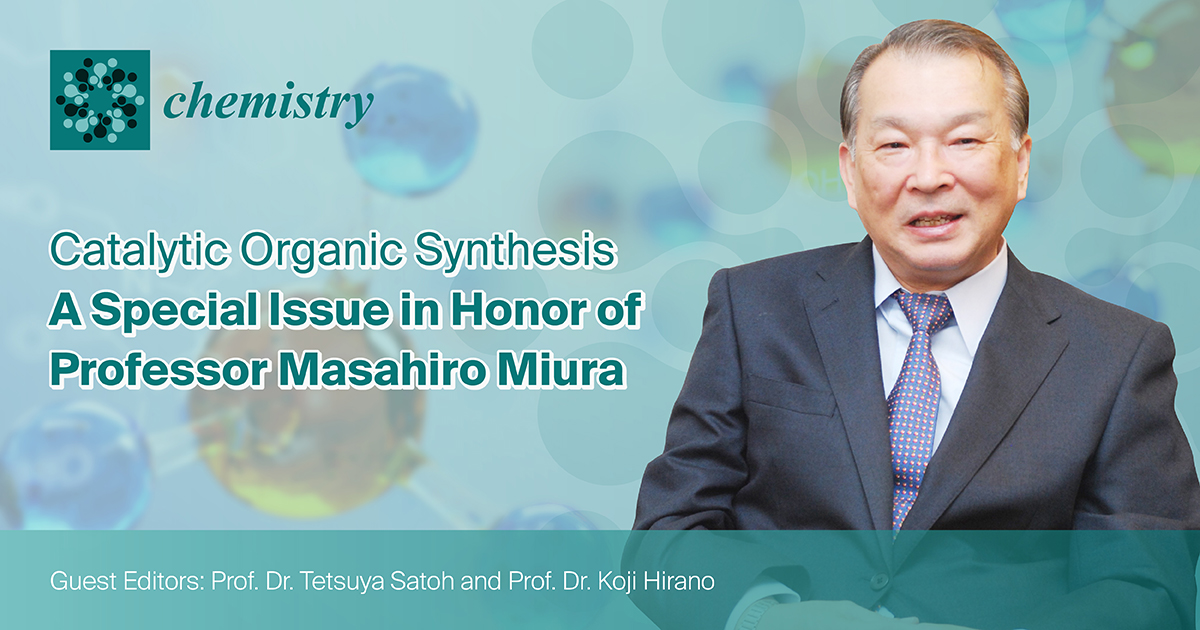Catalytic Organic Synthesis—a Special Issue in Honor of Professor Masahiro Miura
A special issue of Chemistry (ISSN 2624-8549). This special issue belongs to the section "Molecular Organics".
Deadline for manuscript submissions: closed (30 November 2023) | Viewed by 9892

Special Issue Editors
Interests: organic synthesis; transition metal catalyst; C–H functionalization; cross-coupling
Special Issue Information
Dear Colleagues,
This Special Issue of Chemistry is dedicated to Professor Masahiro Miura for his outstanding contribution to catalytic organic synthesis. After obtaining a Ph.D. degree at Osaka University, Japan, in 1983, he started his academic career as assistant professor at the Faculty of Engineering, Osaka University, in 1984, and was promoted to associate professor in 1994 and full professor in 2005. He also worked as a Humboldt postdoctoral fellow at Karlsruhe University, Germany, in 1990–1991. He moved to ICS-OTRI, Osaka University, as a specially appointed professor in 2021. He has made significant contributions to the areas of catalytic chemistry and π-conjugated molecule synthesis, and is one of the renowned pioneers of direct coupling reactions via C-H bond cleavage, which are currently recognized to be highly important in realizing atom- and step-economic synthesis in environmentally benign manners.
All contributions related to the activity of Prof. Miura including catalysis, organometallics, and π-conjugated molecule synthesis are warmly welcomed.
Prof. Dr. Tetsuya Satoh
Prof. Dr. Koji Hirano
Guest Editors
Manuscript Submission Information
Manuscripts should be submitted online at www.mdpi.com by registering and logging in to this website. Once you are registered, click here to go to the submission form. Manuscripts can be submitted until the deadline. All submissions that pass pre-check are peer-reviewed. Accepted papers will be published continuously in the journal (as soon as accepted) and will be listed together on the special issue website. Research articles, review articles as well as short communications are invited. For planned papers, a title and short abstract (about 100 words) can be sent to the Editorial Office for announcement on this website.
Submitted manuscripts should not have been published previously, nor be under consideration for publication elsewhere (except conference proceedings papers). All manuscripts are thoroughly refereed through a single-blind peer-review process. A guide for authors and other relevant information for submission of manuscripts is available on the Instructions for Authors page. Chemistry is an international peer-reviewed open access semimonthly journal published by MDPI.
Please visit the Instructions for Authors page before submitting a manuscript. The Article Processing Charge (APC) for publication in this open access journal is 1800 CHF (Swiss Francs). Submitted papers should be well formatted and use good English. Authors may use MDPI's English editing service prior to publication or during author revisions.
Keywords
- homogeneous catalysis
- C–H bond cleavage
- C–C bond cleavage
- C–C bond formation
- direct coupling
- annulation
- cyclization
- fused aromatic compound
- carbo- and heterocycle synthesis






